MAKING OF “Go Home Late (Tokyo 2007)”
由专筑网韩平,刘庆新编译
Lê Anh Nhan 是越南的一位3d艺术家。他在大学里学习建筑设计五年,在大学四年级的时候他开始对3dmax&V-Ray开始感兴趣并开始学习钻研。大学毕业后,他始终对于CGI充满热情,所以他也一直跟随着ArchVIZ 不断学习。今天,我非常荣幸与你们分享他最杰出的作品“东京2007”幕后的制作过程,该作品也是他送给他妻子的一个礼物。下面就把制作过程分享给大家。
Lê Anh Nhan is a 3d Artist from Vietnam. He studied 5 years in the university of architectural design, and got interested and use 3dsmax & V-Ray during his 4th year there. His passion for CGI got him to follow ArchVIZ after the university. Today I’m very happy to share with you all the process behind his AMAZING work – Tokyo 2007, done as a tribute for his wife. Enjoy!
Introduction/简介
大家好!
首先,我非常感谢Ronen给我这个机会和你们一起分享“晚归(东京2007)”效果图的制作方法,我十分荣幸。
在效果图的制作方面,我仅有两年的经验。在这里与大家分享的所有东西都是我自己摸索出来的,我没有参加过专业的培训课程,只利用网络进行学习。
如有不对之处,还望大家多多包涵,也欢迎大家指正。
下面就让我们从该项目的灵感谈起吧。
Hi, everybody!
I’ll start with thanking Ronen for giving me this opportunity to share with you the method used for “Go Home Late (Tokyo 2007)”. It is a great honor for me.
I only have 2 years experience in the profession. All the things I am sharing with you here I have learned by myself, without training courses, just study on the internet. It may contain flaws, so pay attention to this fact. I hope everyone can sympathize with me.
Let’s start with the inspiration behind the project.
Inspiration/灵感
我为什么要做这张图片呢?
我刚刚结婚,每晚我都在等待很晚下班回家的妻子。我非常爱我的妻子,我想为她做些什么事情。因此,我开始在其他艺术家的作品中寻找灵感,庆幸地是我身边有很多值得学习的优秀作品。
当我看到有杰出的3d艺术家Gleb Alexandrov制作的“大城市的感官刺激”渲染图时,我知道这就是我想要的。
Why did I create this image?
I just got married and each evening I waited for my wife coming back home late after work. Since I love her very much, I wanted to do something for her. I look for inspiration in the works of others artists which, thankfully, there are many of around us to learn from.
It was a coincidence when I saw the work “Big City Sensory Overstimulation” which was performed by Gleb Alexandrov, a very talented artist.
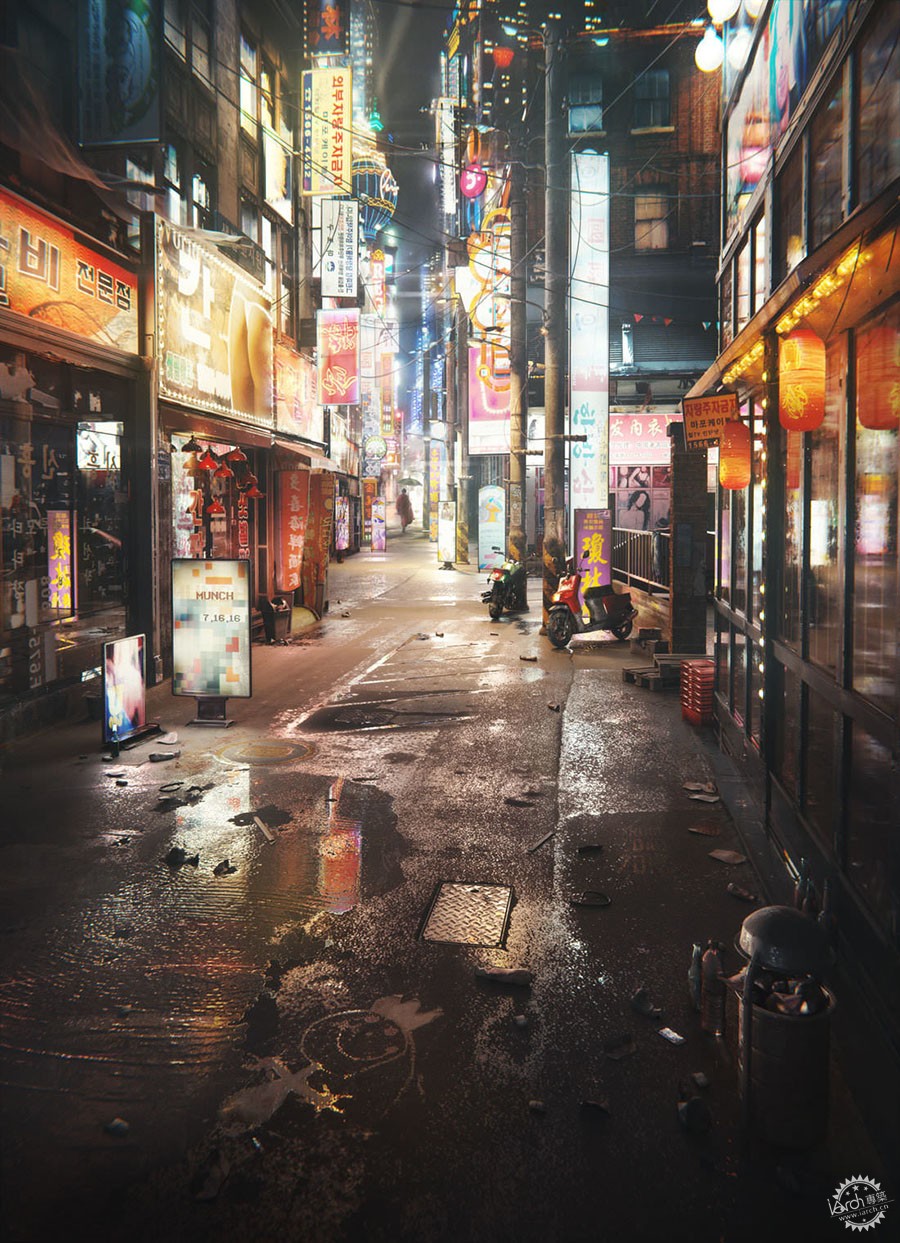
此外,从Cornelius Dammrich发布的名为“52HZ”的作品中,我也备受启发。
And I was even more inspired when Cornelius Dammrich published the work “52HZ“.
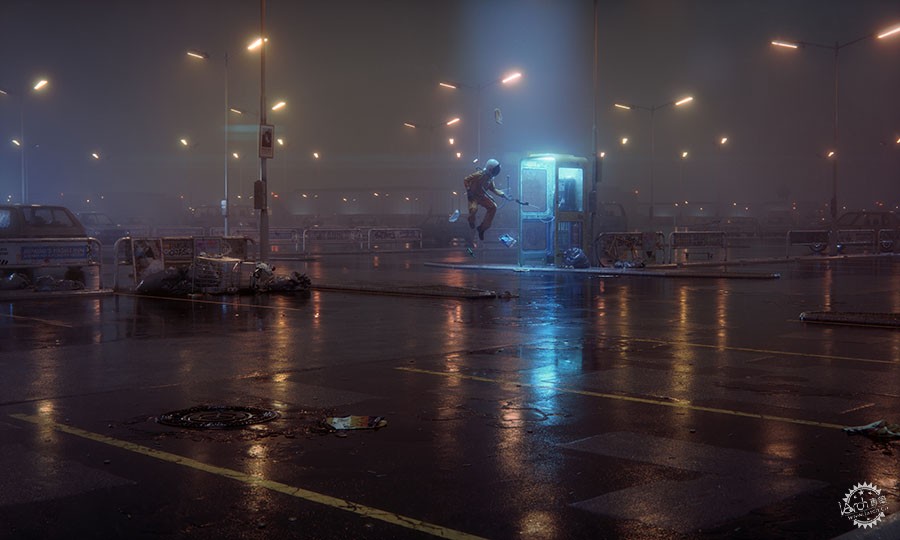
我承认,我非常喜欢这两张图片。
我也决定制作类似的作品,甚至与它们相同,但是用我自己的方法。由于商业工作也快到了交图的时间,我几乎没有时间来做这个。我每周只有8个小时来做这个,而且建模和材质贴图也不是我的强项。但是我在观察周边事物上很在行,所以我开始从该项目所需要的参考图片做起。
I confess, I was addicted to these two images.
I’ve decided to do something similar, also “crazy” like them but in my way. Due to commercial work deadlines, I had very little time to do it. I had only 8 hours a week to do it, and modeling and texturing are not my strengths. I am the best at observing everything around us. So let’s start with my references in this project.
References/参考
我认为这是非常重要的一部分。人们总是会天马行空的进行各种想象,但是我们必须与我们周围的实际结合,这也需要我们花一些时间理解它们,并将它们转化成我们的图片。在做事之前,我通常会仔细观察,了解其本质,然后再开始制作。
以下就是我非常喜欢的一些参考。
I think this is the most important part. Human imagination is wonderful, but we must connect what we do with the reality around us, which takes the time to understand in a way we can translate to our images. Before doing something, I often observe carefully, understand the nature of it, then I start drawing.
Here are some references that I love…
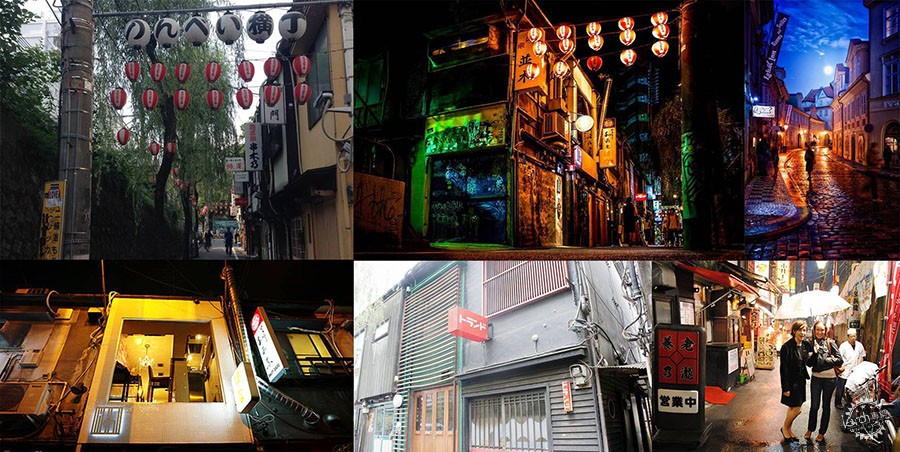
3d Modeling/3d 建模
这对于我来说是非常耗时的一个部分。
在这张图片中,我希望能准确表达这个小巷建筑的当前的状况。从建筑,电器设施的位置,甚至电线都与实际保持一致。一开始我就利用了照相机和cubes,这样是我的工作习惯,这可以使得后期的工作更加简单。
This is the most time-consuming part for me.
On this image, I want to do exactly with the current state of the buildings in this small alley. From architecture and location of electrical equipment, even the way matching electrical wiring must be the reality. To start with a camera and the cubes. I always do that because it helps my job easier.
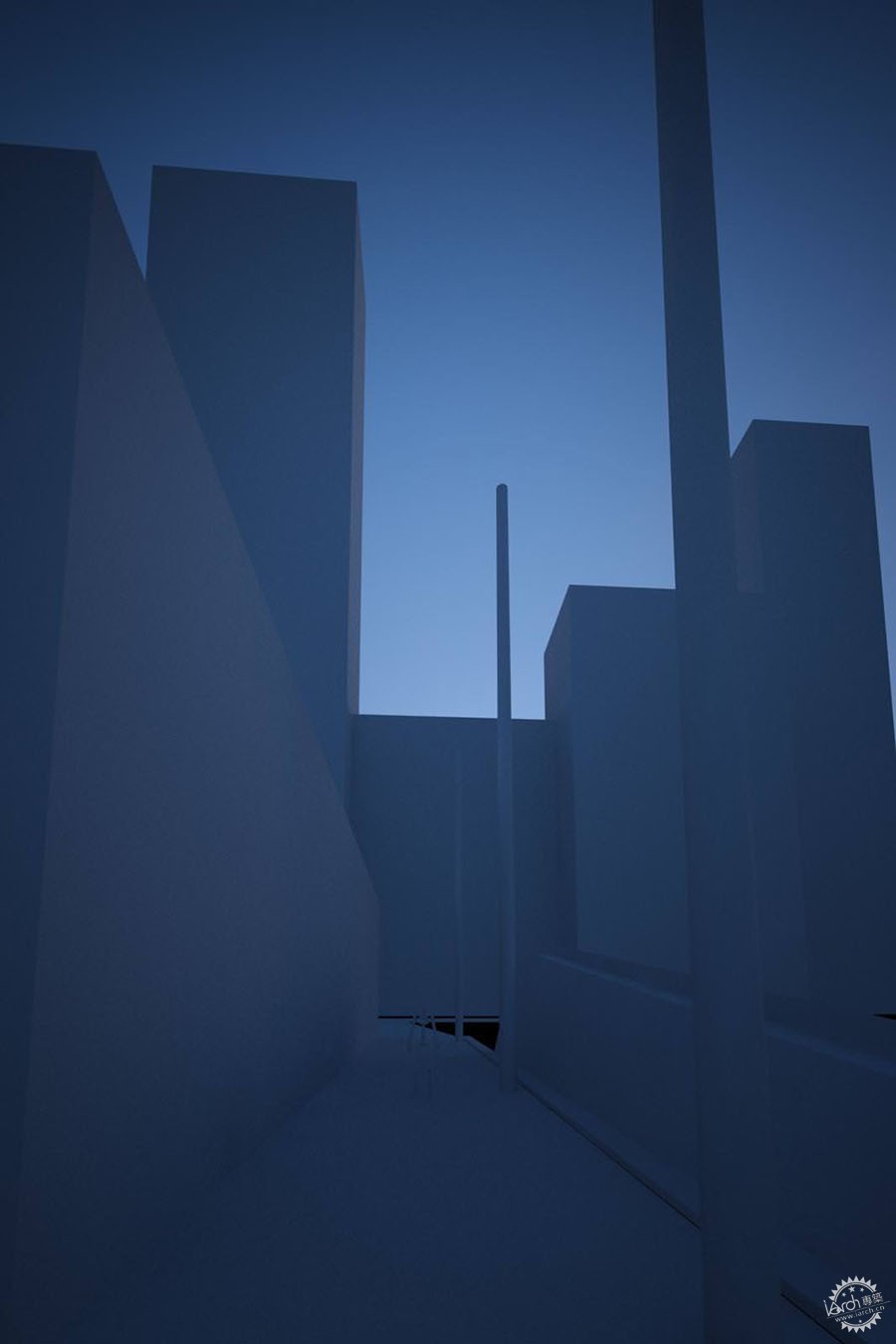
在细化我们的模型之前,我想跟大家分享一个经验,也许大部分人都知道这个,就是对于3d模型中所有锋利的边缘我们可以进行倒角。这样就与我们在现实生活中看到的相似。这样也使我们建立的模型具有可信度。
说实话,我觉得3d建模是最漫长的过程,因为它需要很多的细节。如果有必要的话,你也可以在最后加一层雾气。只要创建你需要的细节,这是我一直秉承的信条(当今,360’s和VR技术越来越流行,这也有助于使大家的场景更加真实。)
在这个场景中有17个建筑。我在3dsmax中进行建模。有一些侵蚀的细节需要利用ZBrush笔刷,具体你们可以参考下面这张图片。
Prior to the model in detail, I would like to share with you an experience which seems everyone knows. All the sharp edges in this 3d model have a “chamfer” on them. It helps with picking up the important highlights on edges we do see in real life. Making everything to be more believable.
I always keep in mind that, to be truthful, even the furthest part of the 3d model, needs this level of detail. You can decide to cover it with fog later if need be. Just have the detail built in for when you need it. That’s just how I trained myself (and today with 360’s becoming more popular as well as VR it will make your scenes more ready for it).
There are 17 buildings in the scene. I modeled them in 3dsmax. There are erosion details demanding the use of ZBrush. You can see this in the image below.
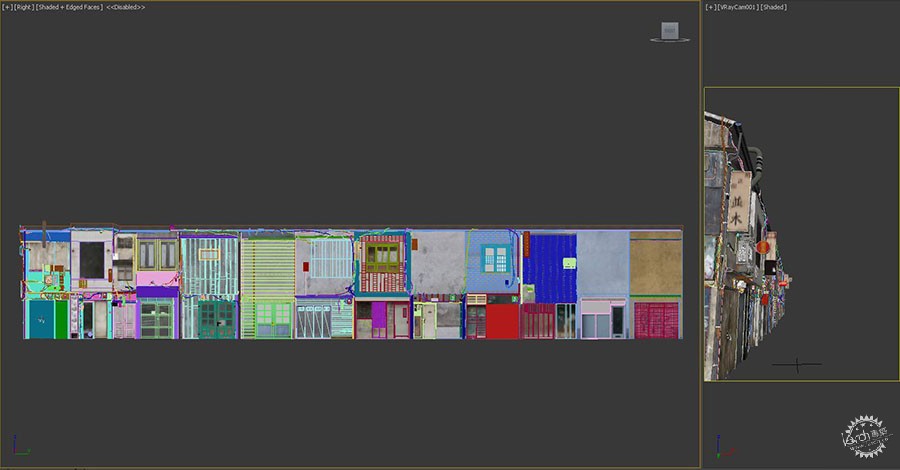
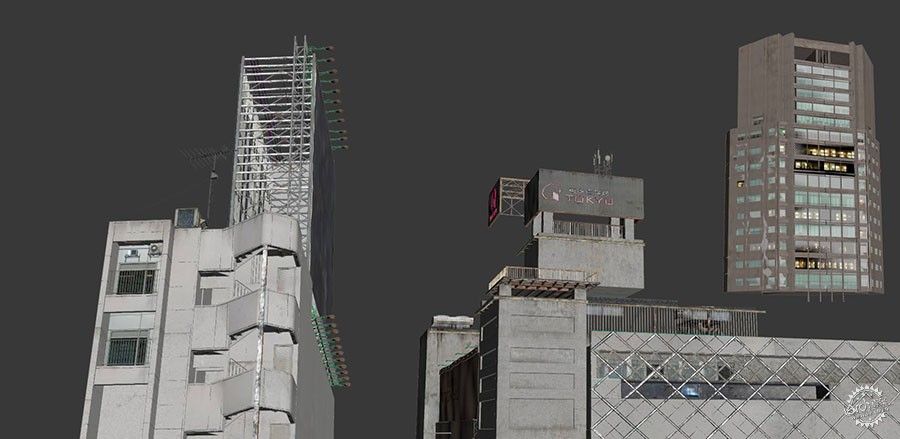
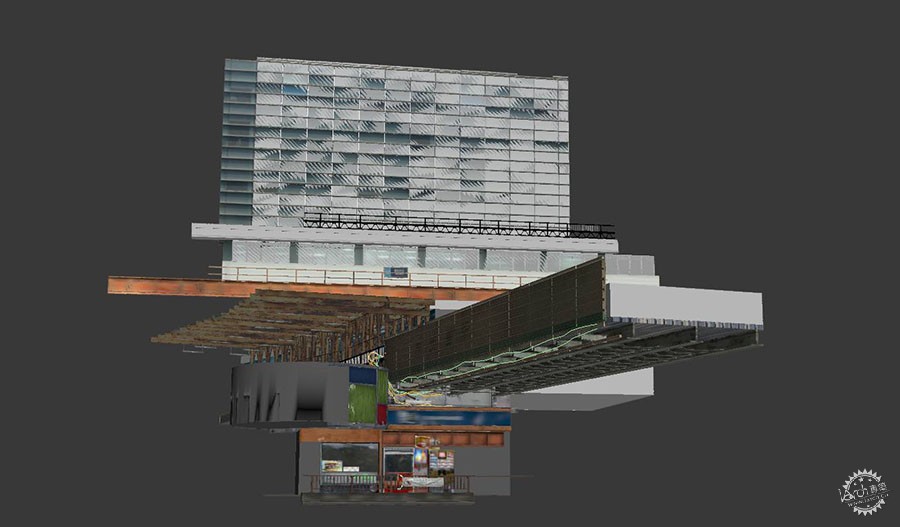
下面是我制作的混凝土侵蚀细节的具体过程。
And this is an example of how I make the concrete details eroded.

我将以下三种笔刷在ZBrush中进行塑形。
I used the 3 brushes below to sculpt in Zbrush.

实际上的柳树几乎是光秃秃的。由于巷子越来越窄,它的部分树枝还被锯断了。我在SpeedTree中利用三种不同的模型创建了这棵柳树。
你可以在Youtube搜到很多SpeedTree的使用教程。
另外,我也利用 GrowFX创建了柳叶。
The Willow, in fact, is very bare. It has truncated branches because the alley is too narrow for growing. I modeled the willows in SpeedTree with 3 different models.
You can see instructions on how to use SpeedTree on Youtube, there are many tutorials about it.
I created the leaves with GrowFX.

弯曲的叶片是很重要的,因为它们会有特别的高亮显示,尤其是在雨后,十分必要。
Incurvation of the leaf is very important, it helps with having specular highlights, which is necessary when it have just stopped raining.
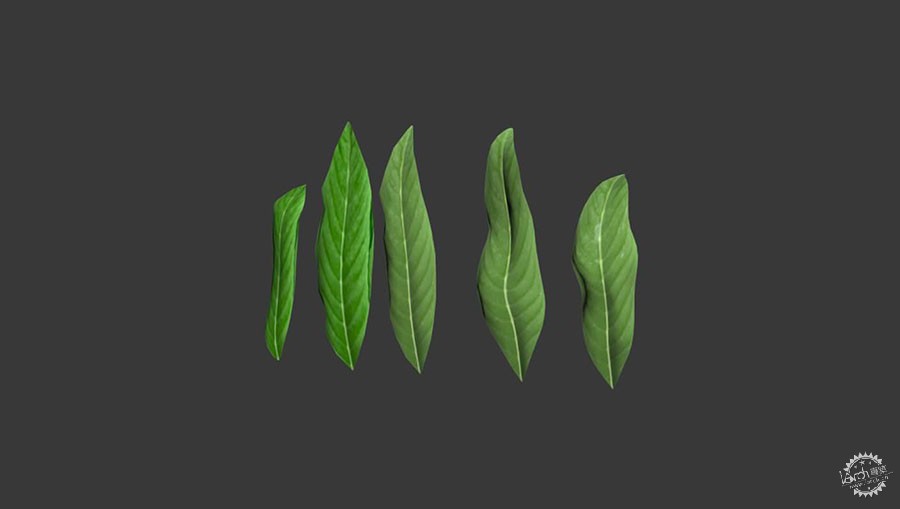
3dsmax中的最终成果。
Results in 3dsmax…
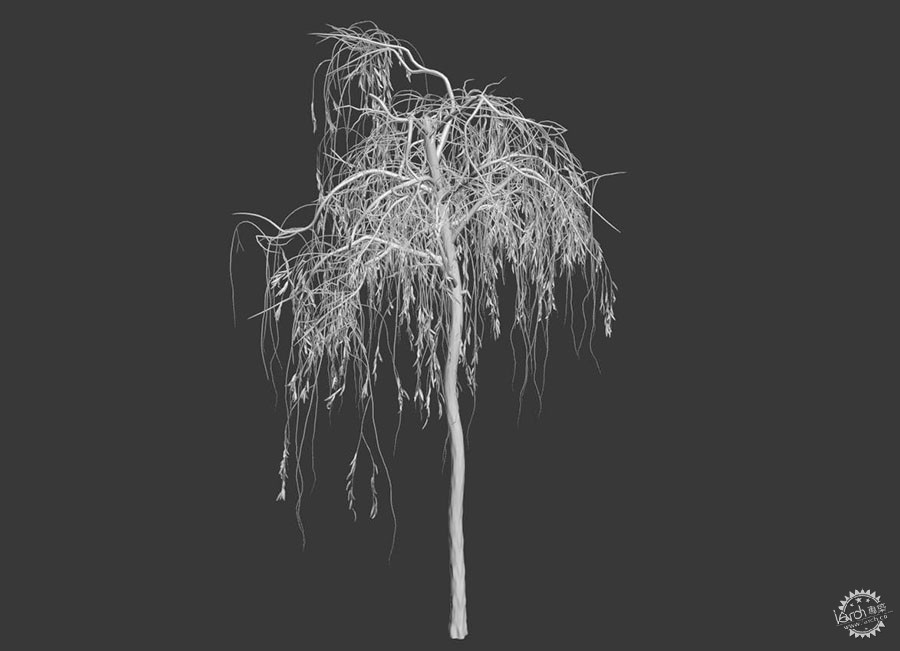
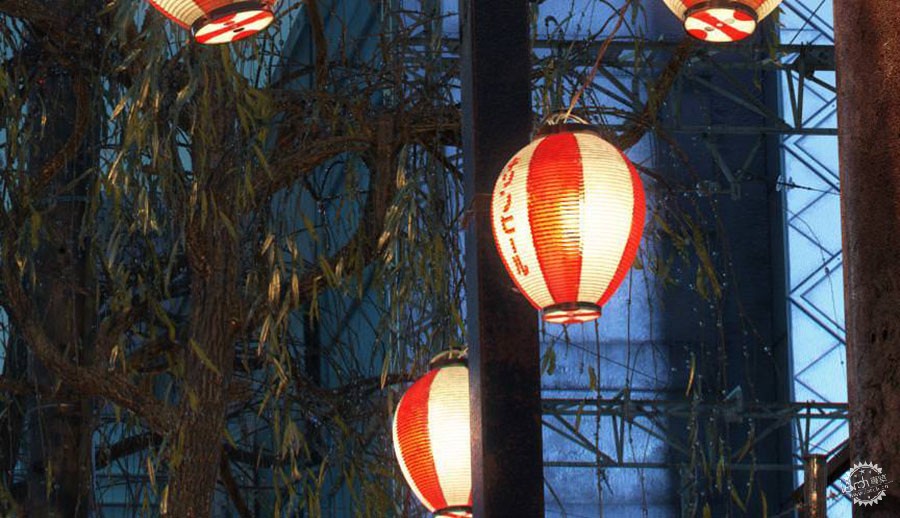
叶片上的雨珠是利用MultiScatter进行分布的。
我还手动在电线上分布了一些雨滴,虽然几乎看不到,但是为了营造雨后的氛围,还是有必要创建的。
这就是我在3dsmax中建的最后的模型。
Raindrops on my leaf are distributed with MultiScatter.
I had to manually distribute raindrops deposited on the wire. It is difficult to recognize. But it is necessary to create the mood after the rain.
This is the model created in 3dsmax…
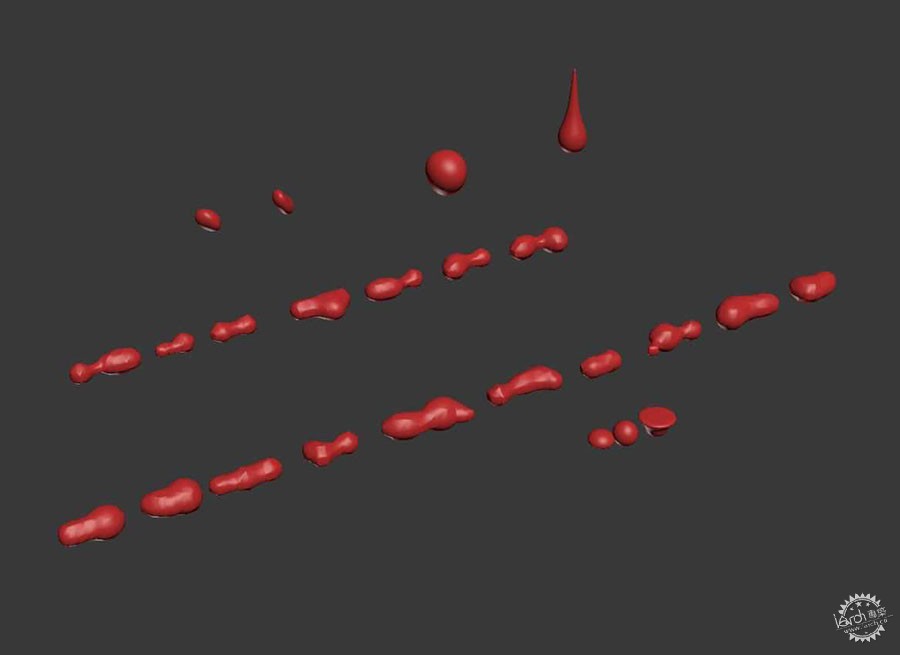

下面我会跟大家提几个特殊模型的创建方法。
我想跟你们分享是我如何建塑料包装模型的方法。
我怕使用了3dsmax中的MassFx,按照物理学的原理,使它能够像布一样悬挂起来。
I will just mention some specific models further.
I want to share with you how I modeled the plastic packaging.
I used MassFx of 3dsmax and made it hang down like cloth in accordance with the rules of physics.
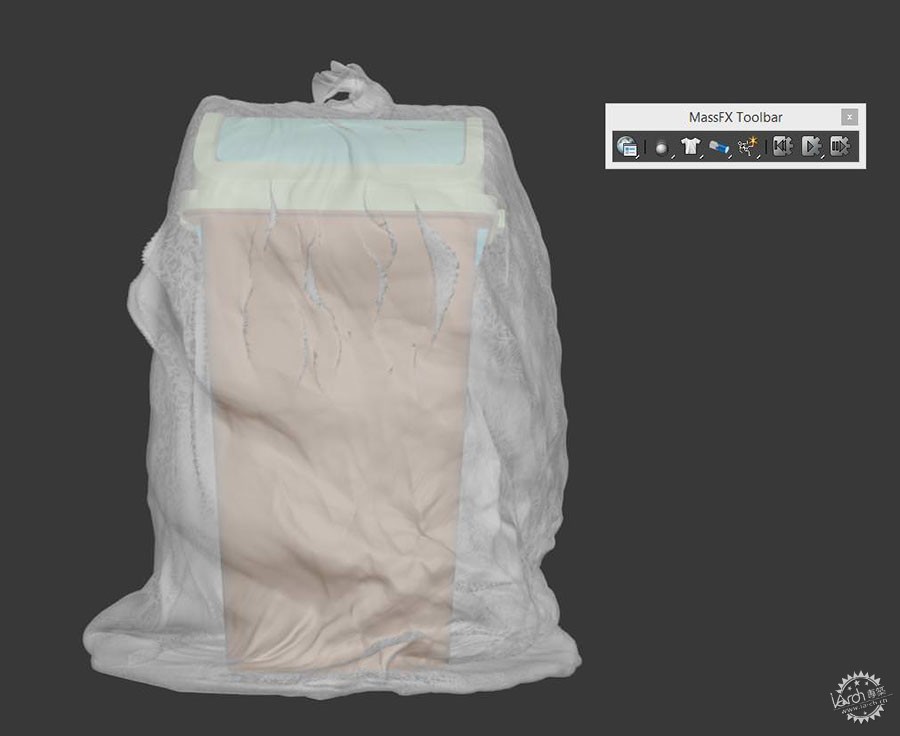
然后利用ZBrush增加褶皱细节。
And added sculptural details in ZBrush.
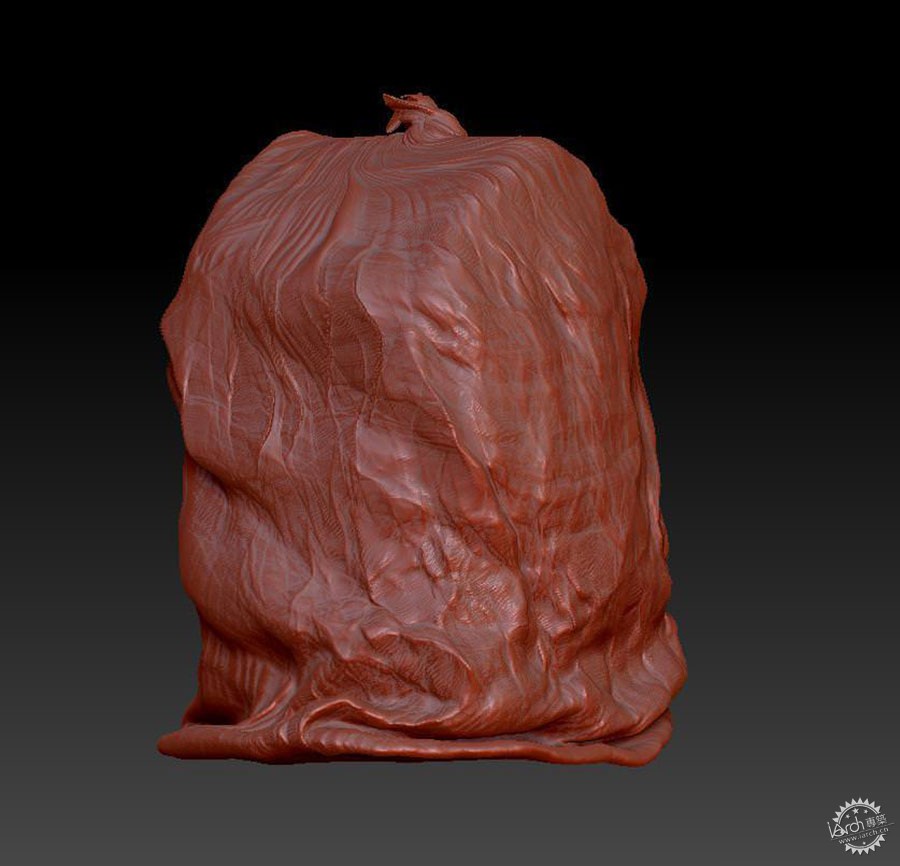
这个垃圾填埋厂和雨伞的模型建立相似。
Similar to landfills and umbrellas.

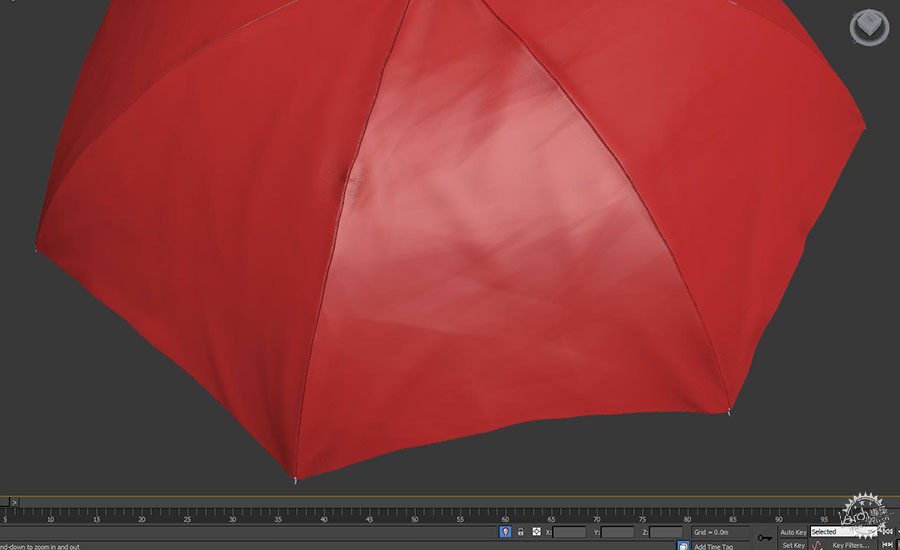
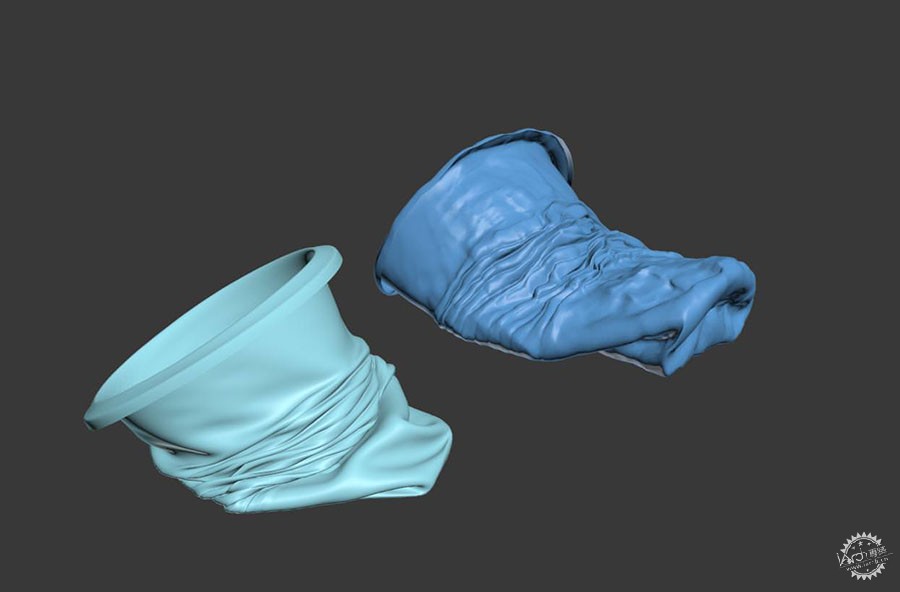
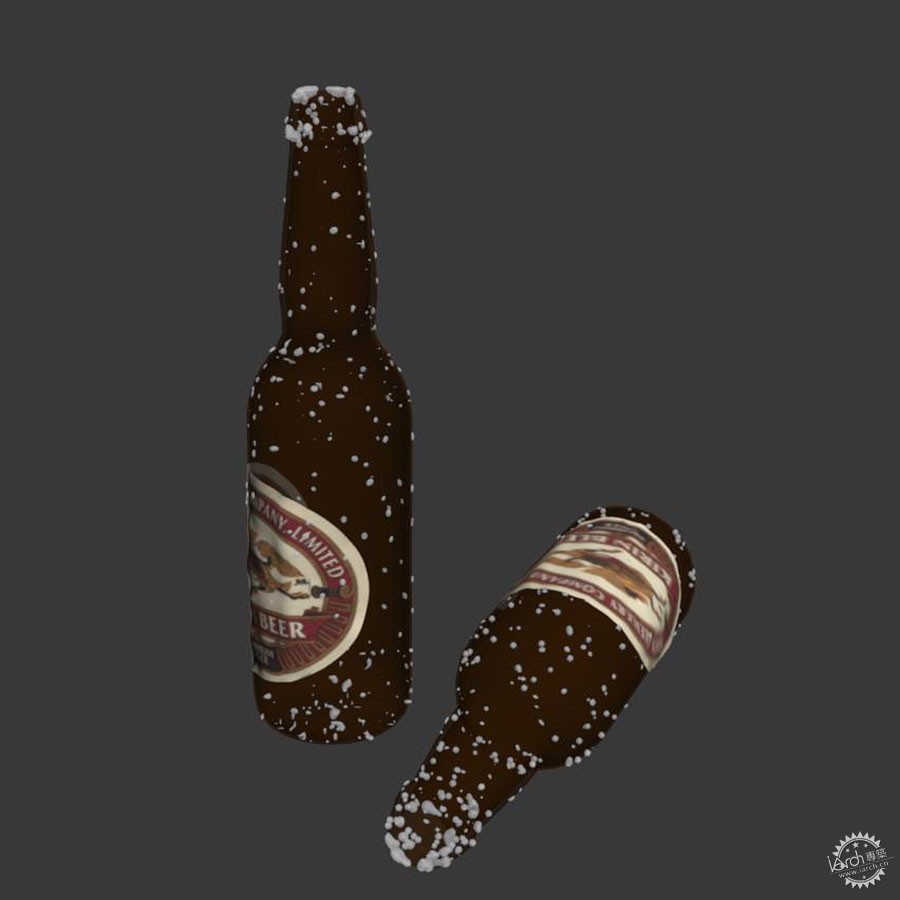
以下这些是一些小酒馆的概念。
And here are some concepts of pubs.
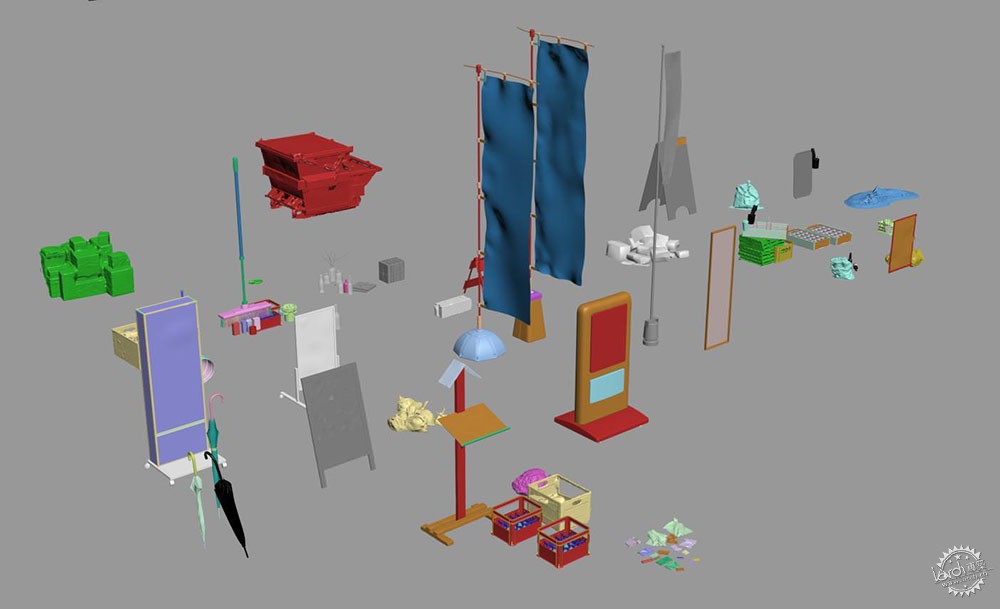
一些电器的模型。
Some models of electronics.
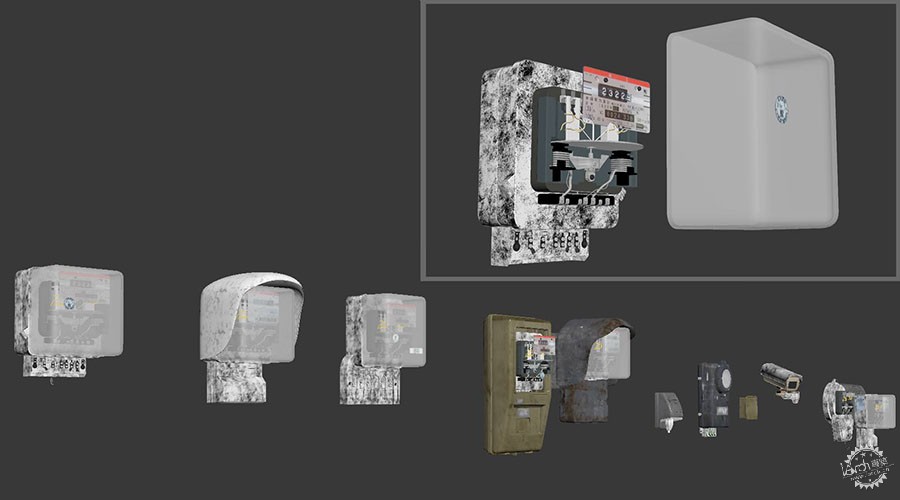

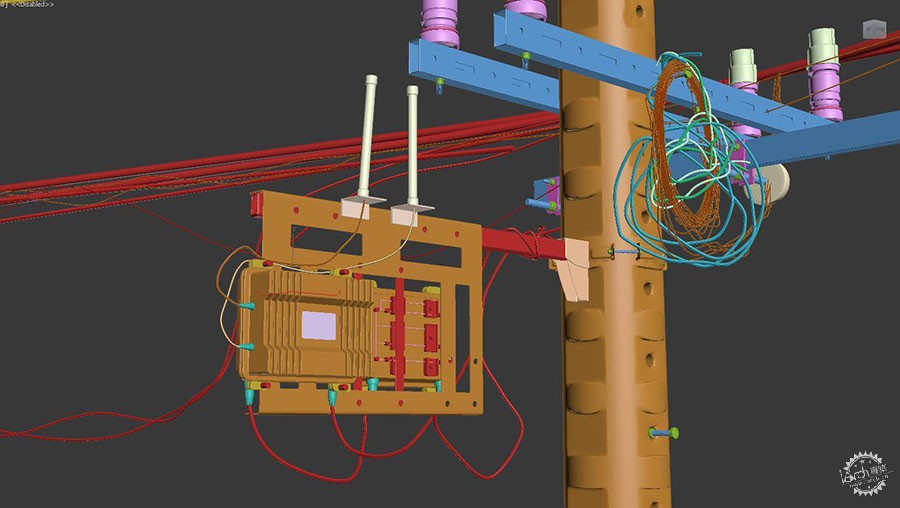
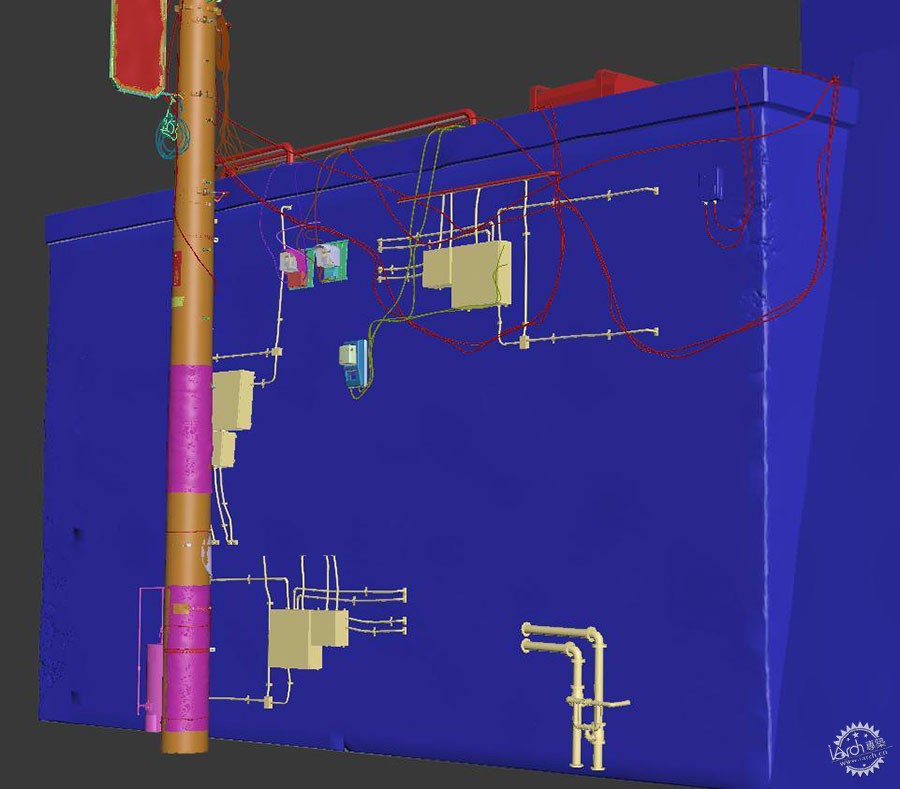
我希望一切真实的细节都有,我也希望一切都能保持高度的真实。场景中没有虚构,否则我会非常难受。
I wanted all to be really detailed. I want it to be true to reality. There is no deception, otherwise, I will feel very uncomfortable!
Texture & Materials/纹理贴图和材质
在这个部分,我只想提几个主要组件的设置。
这个部分要求你有一定的实际观察。我在PS中对于我的纹理贴图进行了不同的混合模式的调整。这部分最大的挑战,也是耗费我时间最多的应该是广告牌的设置。因为我是越南人,我对日本的文化了解不多。所以,我的目标是希望广告牌上的文字正确,而且其贴图的分辨率能够大于4000。所以我决定在PS中手动添加,再进行调整。
In this part, I just mention some main components.
This is the part required your actual observations a lot. I do my texturing in photoshop with different blending modes. The biggest obstacle, which took most of my time is billboards. Because I am in Vietnam, I don’t know anything about Japan. Meanwhile, my intention was that the texts on the billboard will be accurate and textures resolution must be greater than 4000 pixels. So I’ve decided to do it manually in Photoshop and render them all.
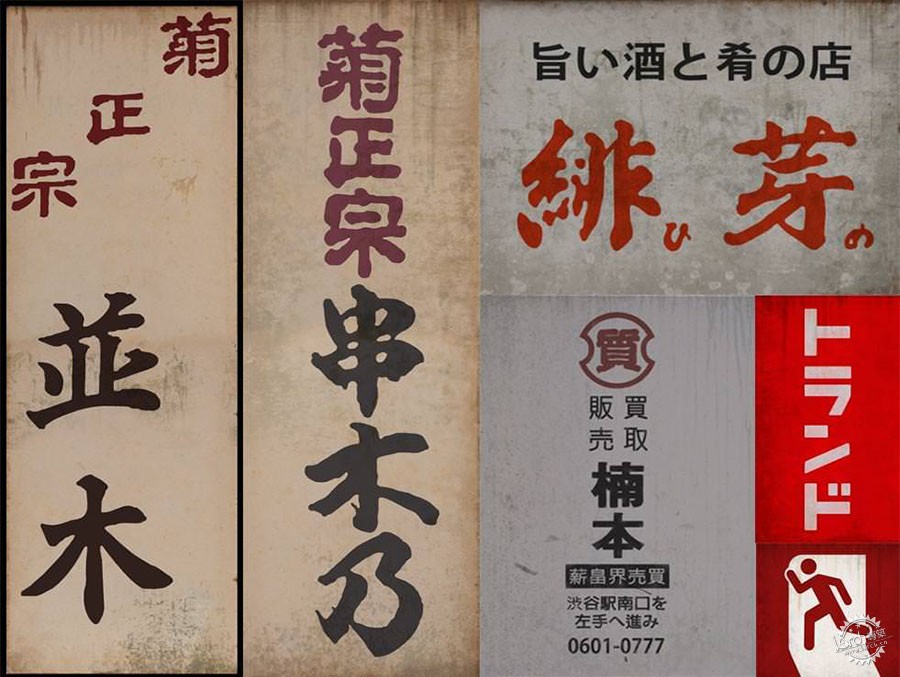
建石墙模型非常耗时。在最后成图的场景中我有一面很长的石墙。为了避免石头的重复,我不得不创建了26种不同的石头模型。
Modeling the stone wall was very time-consuming. With the camera angle of the picture, it required having a very long stone wall in view. To avoid repetition of stones I had to create 26 unique stone models.
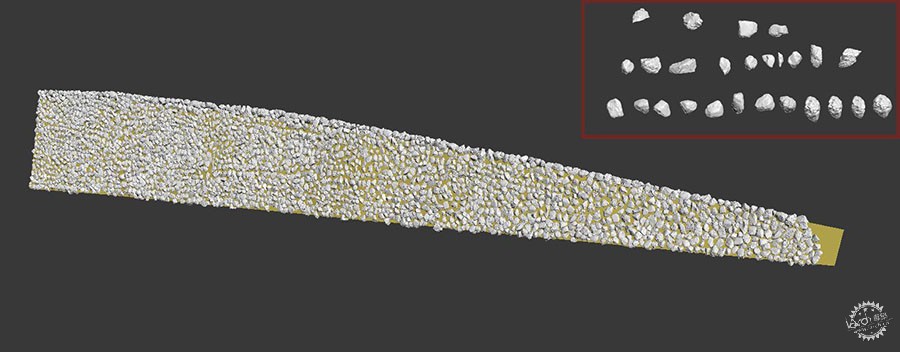

我非常想营造雨后小路的感觉。
我花了两天的时间观察它。幸运地,我住的地方经常下雨。这个方法解释起来有一点复杂。首先,我在3dsmax中建了一个简单的小路模型,然后利用ZBrush增加一些细节。位移贴图是在ZBrush和PS中创建的。反射贴图也类似。
以下是具体案例。
The road after the rain was my obsession.
It took me 2 days to observe it. Luckily, where I live there is much rain. It is quite complicated to explain. I started with a simple path model in 3dsmax, then the model is detailed in ZBrush. Displacement map was created in ZBrush and photoshop. Reflection map is similar.
Here is an example.
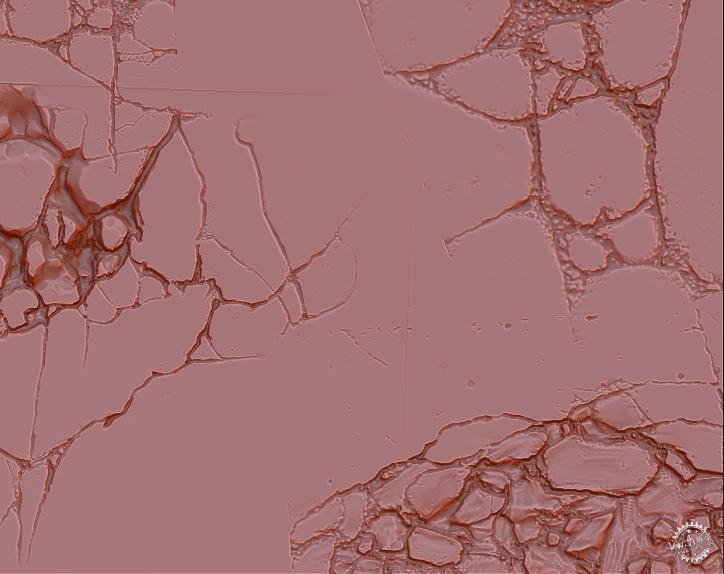
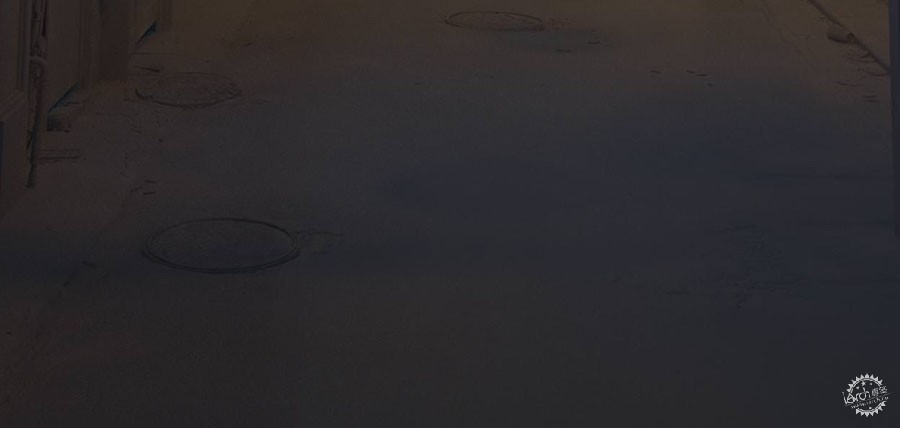
我制作的小路就像刚下过一个小时的雨,所以水坑不是很多,主要出现在道路的凹槽和裂缝处。
I did the road as if it was an hour after the rain… so the puddle is very limited, mainly appear in the grooves and cracks on the road.

最令我困惑的是材质。
暗部+湿沥青+浅色调=???
它像不像灯光下的金属?这真是很危险,很难让人相信这是真实的道路。在湿沥青和金属材料之间的边界是非常单薄的。因此我在设置道路材质的时候需要格外小心。
下面有几个我的参考图片。
What makes me most confused is the material.
Darkness + Wet Asphalt + Light Colors = ???
Is it not like metal under the lights? It is very dangerous, very difficult to let others believe that it is an actual path. The boundary between the wet asphalt and metal material is very fragile. I was very careful when setting up the road material.
These are pictures taken in my references…
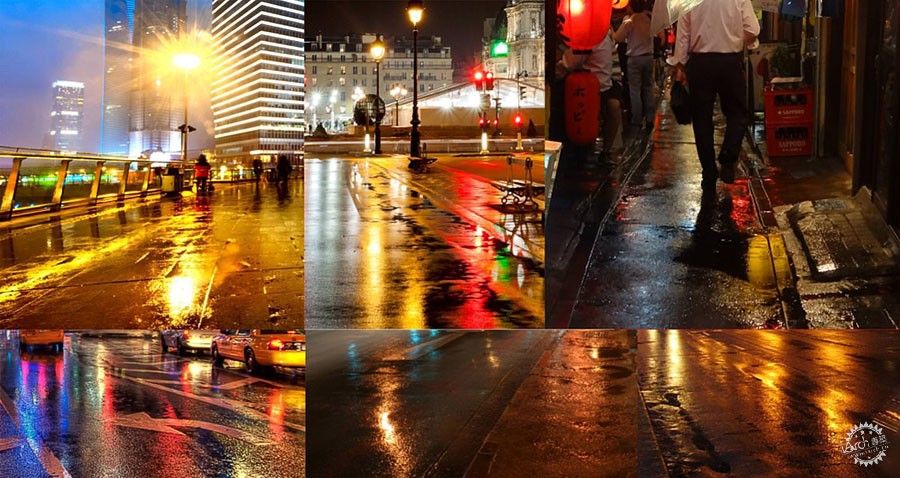
它真的跟金属很相似么?
潮湿的混凝土,潮湿的道路线和潮湿的沥青都是完全不同的材质。我创建了一个α贴图来区分这三种材质。在大多数情况下,我都使用V-Ray混合模式,对于小路也不例外。
我采用的道路材质为:(潮湿的沥青层1+潮湿的沥青层2+水坑裂缝+水坑接触线和混凝土)+(湿线+水坑)+(潮湿混凝土+混凝土上的水坑)
这是材质路径的图例。
下图是第一个分支图。
Is it pretty similar to metal?
Wet concrete, wet lines and wet asphalt are completely different materials. I created an alpha map to differentiate the three materials. I mainly use V-Ray blend in most cases, the path is no exception.
This is my recipe of road materials : (wet asphalt level 1 + wet asphalt level 2 + puddles in the cracks + puddles exposed the line and the concrete) + (wet line + puddles on the line) + (wet concrete + puddles on the concrete)
Here is a diagram of the material of the path.
This is the first branch of the diagram.
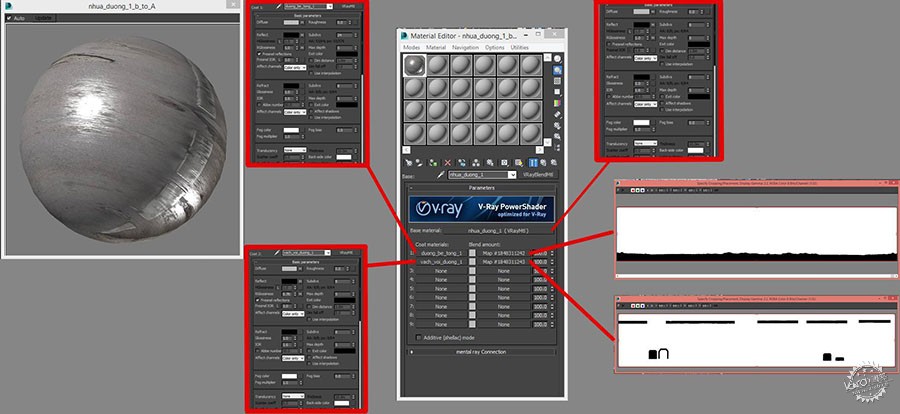
为了避免重复,我设置了三个版本的道路。还在道路上增加了一些汽油的印记这样能够使这条路在灯光下看起来更吸引人。
以下就是最终的效果。
I created three versions of the road to avoid duplication. Add a bit of oil spilled on the road so as to the road look more attractive under the lights.
And the result is…
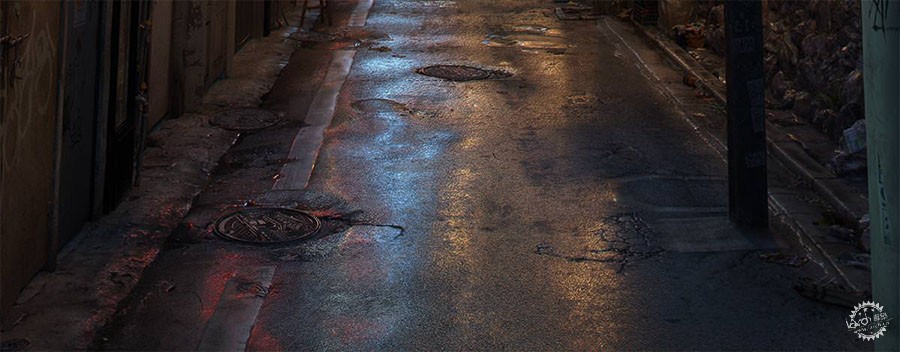
潮湿石头材质的一个案例
An example of the wet stone material.
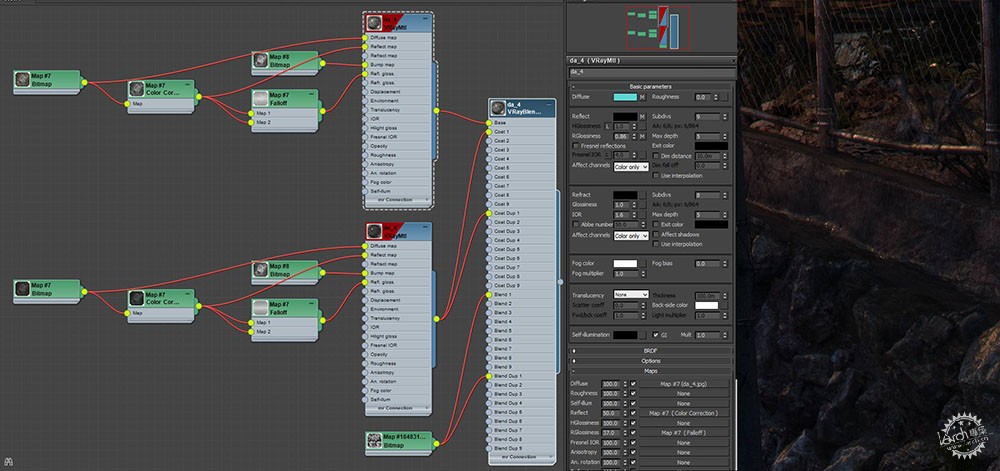
我通常也使用V-Ray的混合功能来设置生锈的金属材料。
I often use V-Ray blend for rust metal materials too.
Lighting/灯光设置
这是我最喜欢的部分!
这决定了整个图片的整体基调。这是我的灯光设置。
使用一个球形灯和一个来自Peter Guthrie的HDRI灯光。
以下就是灯光的一些具体设置。
This is my favorite part!
It is critical in the creation of the mood of the image. This is my lighting setup.
Use 1 Dome light + 1 HDRI from Peter Guthrie.
These are my light settings…

三盏路灯和五个灯泡(一个已经烧坏了)。没有什么秘密可言,对于每个灯泡我都设置了一个V-Ray灯。
我想着重提下怎么设置灯笼。灯笼的照度范围很窄,它只能反射到相邻的物体。
下图是灯笼的内部结构。
3 streetlights and 5 bulbs (1 bulb has burnt). Nothing is a secret here, I only use 1 V-Ray Light sphere for a bulb. And here are the setting…
I will mention how to set up my lantern light. Operating range of lantern light is quite narrow, it only affects the objects near it.
The interior structure of the lamp.
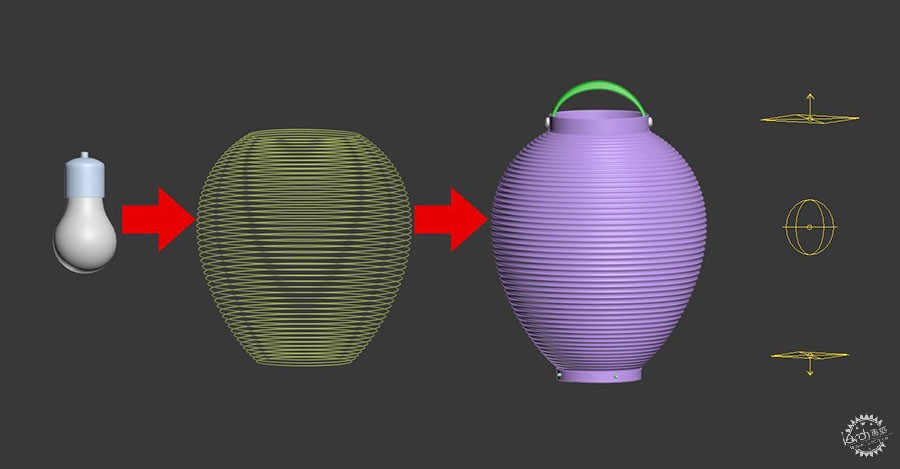
这些是标识灯的设置。
These are the sign lights settings…
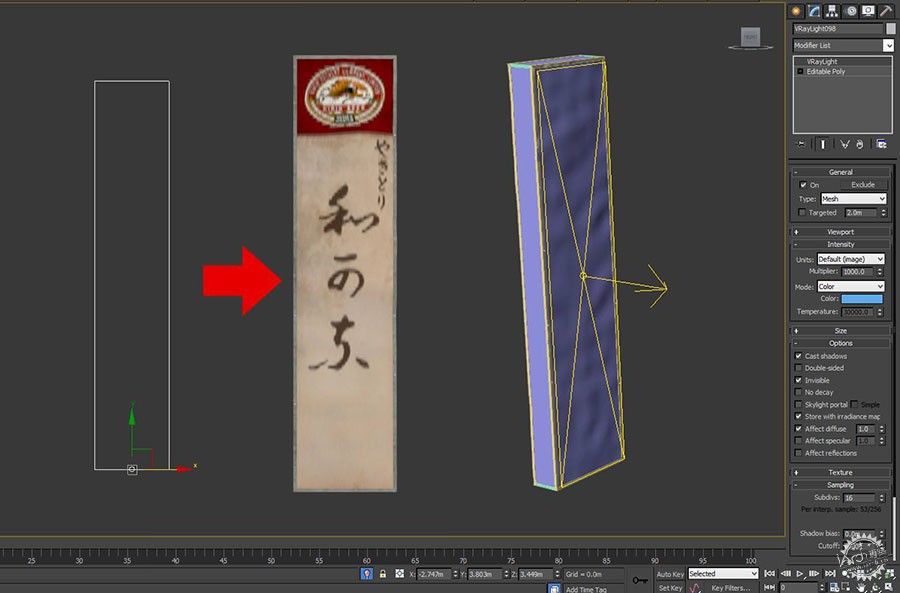
你可以在之后的视频中看到设置灯光的顺序。
You can see the video below for sequences setting my light.
Render Setup/渲染设置
我使用了V-Ray渲染器来创建这个图片(我猜这应该是最普遍使用的渲染工具)。它既快速又容易操作,而且我想未来的一段时间我还会使用它的。这就是我通常会使用的相机和渲染设置。
我想这应该是非常基础的。
I used the V-Ray render engine to create this image (which is the most common tool I guess). It is fast and easy to handle! And I think in the future I will still use it. This is the camera settings and render that I usually use.
Pretty basic, I think so.
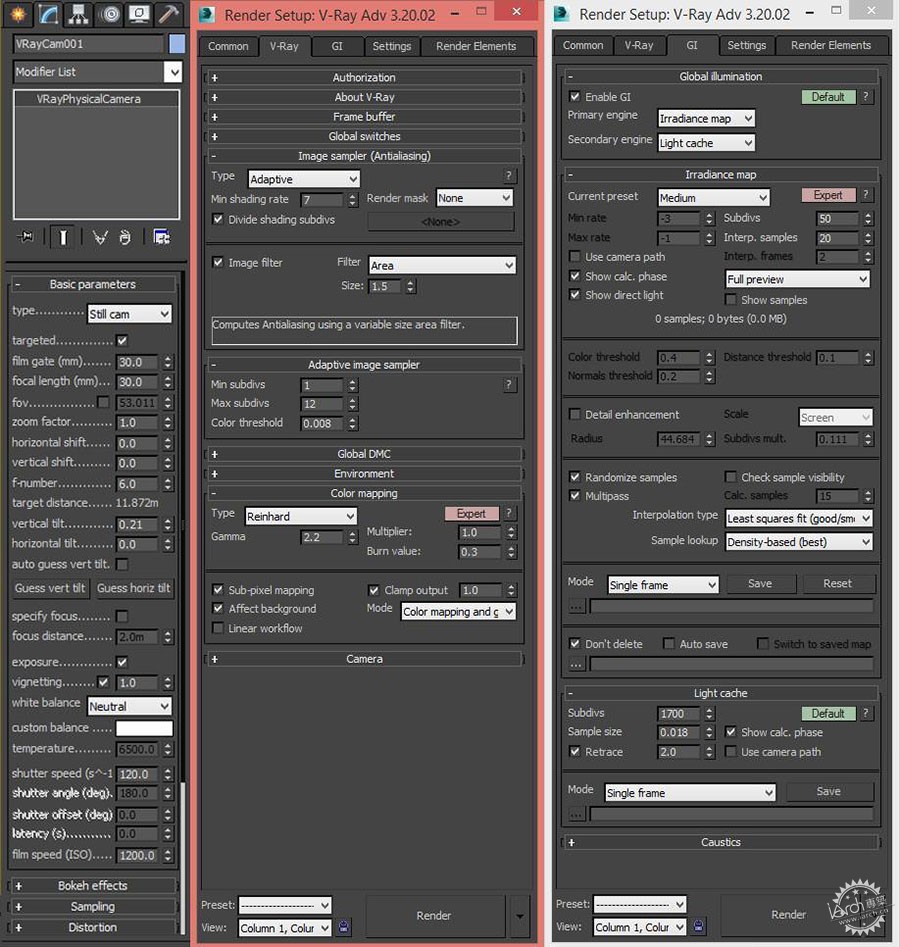
以下是最后的效果图。
Below is the final render…
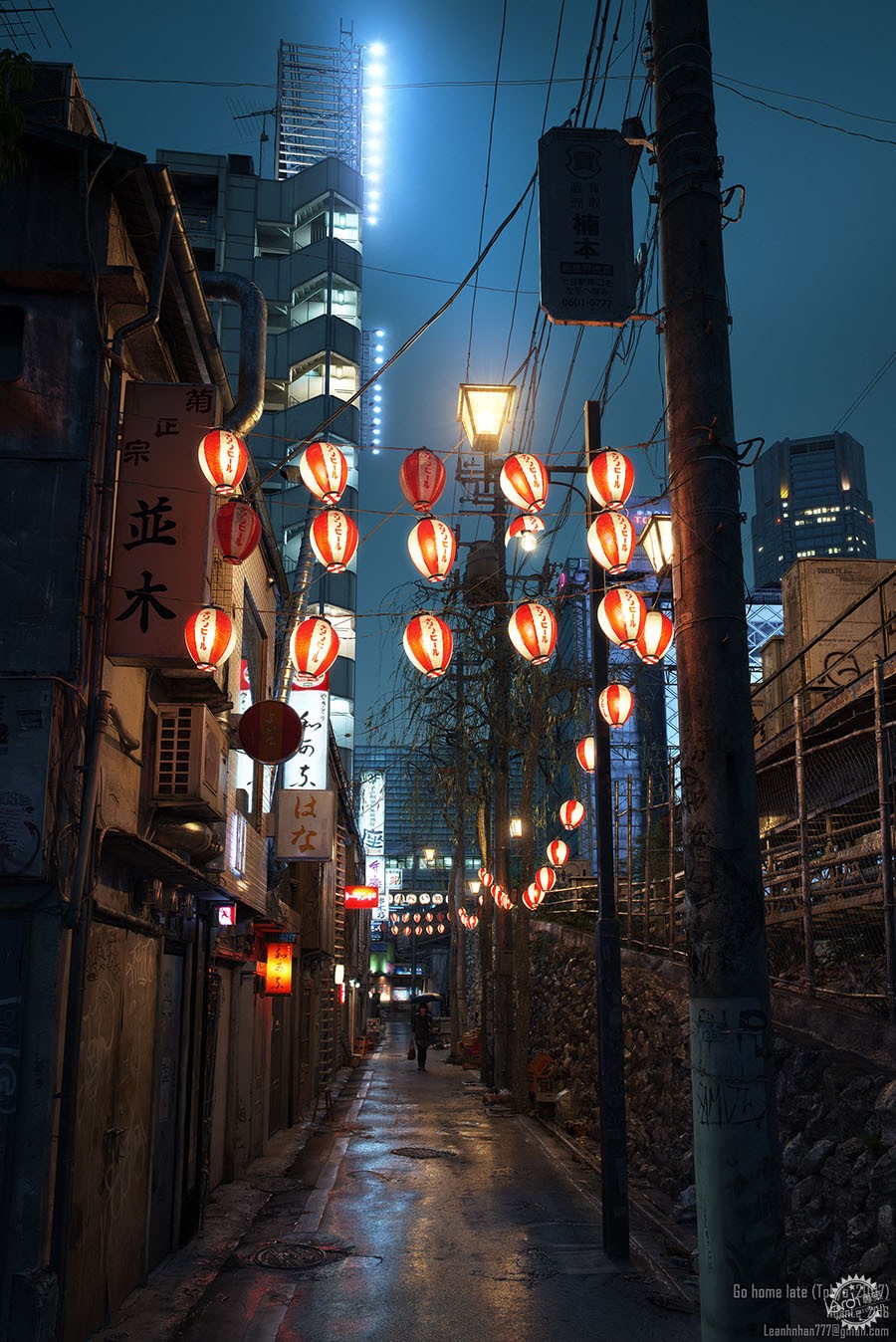
Post Production/后期制作
请随时查看制作过程视频。
Please feel free to check out the making-of video…
感谢你们阅读这篇教程文章,我希望您能够在这里找到一些感兴趣或者有用的东西。
Thank you for reading this “making-of” article and I hope you found some interesting and useful advice in it!
出处:本文译自www.ronenbekerman.com/,转载请注明出处。
|
|
